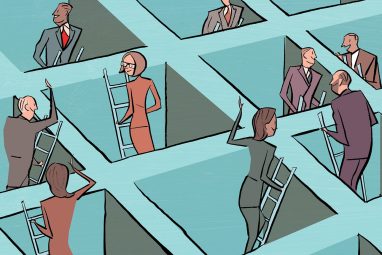Twenty Years of Open Innovation
Two decades of open innovation have shown that the biggest barriers are inside, not outside, the organization.
News
- Gulf Nations Fast-Track AI Ambitions, UAE Leads Regional Readiness, says BCG report
- AI professionals form a redefined workforce. But systemic roadblocks persist, survey finds
- AI-Driven Scams Surge as Microsoft Blocks $4 Billion in Fraud Attempts
- Identity-based Attacks Account for 60% of Leading Cyber Threats, Report Finds
- CERN and Pure Storage Partner to Power Data Innovation in High-Energy Physics
- CyberArk Launches New Machine Identity Security Platform to Protect Cloud Workloads

Carolyn Geason-Beissel/MIT SMR
Twenty years ago, I introduced the concept of open innovation in an MIT Sloan Management Review article. Where do we stand two decades later? We’ve seen some companies enjoy great success with this approach and witnessed the difficulties of others. One surprising insight 20 years on is that the biggest barriers to successful open innovation are inside, not outside, the organization.
Open innovation emphasizes drawing on external resources — such as customers, startups, crowdsourcing platforms, and universities — to develop ideas for new products and services. More formally, it can be defined as a distributed innovation process involving knowledge flows across organizational boundaries, for both pecuniary and non-pecuniary reasons. To innovate, we need to move knowledge from where it resides to where it is needed. Often, this means moving people so that knowledgeable workers can collaborate together to create something new. At other times, it might require new workflows and structures to create incentives and procedures to move that knowledge. To achieve success with open innovation, organizations need the ability to mobilize and access their knowledge across all of their silos — whether functional, departmental, or geographic — to design, develop, and deliver the innovations that their customers want.
There’s much to celebrate about two decades of open innovation. Many studies have found evidence that it improves financial performance.1 National studies employing the Community Innovation Survey have found that organizations with more external sources of knowledge achieve better innovation performance than those with fewer sources, controlling for other factors.2 One survey of 125 large companies also found that organizations that employed open innovation were getting better innovation results.3
Despite this success, much remains to be done. For open innovation to succeed, it is not enough to identify possible useful sources of knowledge, access those sources, negotiate possible collaborations with them, and then incorporate that new knowledge into new innovative products and services. More in-depth studies find, in fact, that the biggest problems that organizations face in using open innovation often come from inside, rather than outside, their own walls. Collaborating and coordinating with external actors in open innovation often requires changes to organizational workflows and can trigger defensive responses from internal innovators.
A recent paper clearly documented the internal resistance to open innovation. In Hila Lifshitz-Assaf’s study of the adoption of open innovation practices at NASA, she focused on the use of crowdsourcing to generate new ideas.4 One successful idea allowed NASA to significantly improve its ability to predict solar flares. Within NASA’s Johnson Space Center, however, engineers were troubled by the result obtained from outside the agency. Their sense of identity and their understanding of their role in the organization seemed threatened by the open innovation outcome.
Organizational boundaries that facilitate greater focus and specialization in critical activities can become barriers to open innovation when they result in silos. Useful knowledge flows well within the silo but does not move well between silos, such as different departments, functional areas, or geographies.
Take, for example, a corporate venture capital (CVC) program that invests in new technologies and markets, creating a portfolio of startup ventures. If that same company’s business units typically regard these young ventures as too immature, too distant, and too risky to warrant much attention and commitment, the knowledge from the CVC team will fail to penetrate into any business units that could leverage and scale that knowledge.
Organizational boundaries that facilitate greater focus and specialization in critical activities can become barriers to open innovation when they result in silos.
Intel faced this problem repeatedly in working with promising startups and created a new unit, New Business Initiatives (NBI), to address the problem.5 NBI’s teams developed relationships with new startup ventures and then tried to connect those ventures to Intel business units with two lubricating elements: money and knowledge. The money provided immediate resources for a business unit to integrate the project; previously, business units often had to wait until the next fiscal year to obtain such resources. At the same time, the NBI team that developed the opportunity broke up once the project was transferred to the business unit. Once the receiving business unit started working with the project, it often had questions, but the now-dispersed team was not available to answer them. NBI solved this knowledge problem by deploying one of its team members to travel with the project to the new business unit for six to nine months. That person often knew the answer — or knew how to find the answer — to the business unit’s questions.
There are other ways to overcome the barriers imposed by internal silos. One simple but effective method is to enable people to rotate their positions within an organization, from one silo to another. For example, a manager in the business unit could rotate into the CVC group for six to 12 months, and vice versa. Such rotations help people build contacts and experiences in one silo and then carry those with them to a new part of the organization. Over time, an organization that has rotated 5% or 10% of its staff within a three-year period will find it much easier to identify and access useful knowledge in most parts of the organization and be well positioned to make the internal process changes to leverage that knowledge effectively.
A complementary strategy for rising above internal silos is to assign senior executives responsibility for major customers of the organization. Cisco used to do this regularly, with every C-level executive being given the task of managing their own functional group and becoming the executive champion of the relationship between Cisco and some of the company’s biggest customers. Because the customer innovation needs invariably involved changes from multiple functional groups within Cisco, this forced every executive to think holistically about the company. These innovation opportunities could not advance without the relevant groups understanding their role in creating, developing, and delivering the innovation and what changes they would need to make to achieve it. The functional leader facilitating the collaboration across multiple departments for one customer’s problem often would find other C-suite champions asking her to cooperate with other departments for another customer’s innovation opportunities. Executive bonuses partly tied to new product and service sales at specific accounts further motivated internal sharing and collaboration across departments and functions.
Another mechanism to move knowledge across organizational boundaries is to enable members of each group, function, or department to buy or sell outside the organization if their internal counterparts are unresponsive to their needs. Chinese white-goods manufacturer Haier has created Rendanheyi, a sophisticated system of internal and external contracting within the organization that creates internal markets for the supply and purchase of products and services needed for future Haier offerings.6 This system replaces most of the internal organizational silos that previously restricted the activities of departments. Under Rendanheyi, departments are transformed into micro-enterprises inside the company, with the freedom to contract with anyone inside (and, occasionally, outside) the organization to achieve their objectives. This system has accelerated the speed of innovation inside Haier and opened it up to more external collaborations in the process. It has also enabled the launch of new business initiatives for the company.
Ultimately, 20 years of open innovation have revealed that many of the model’s biggest challenges lie within the organizations seeking to innovate rather than in navigating and negotiating with outside organizations. Getting beyond silos is key to the success of open innovation, a method that has made its mark. Today on LinkedIn, one can find hundreds of thousands of people with “open innovation” somewhere in their profile. Twenty years after the concept’s introduction, we’re poised to see how much further open innovation can go.
References
- J. Du, B. Leten, and W. Vanhaverbeke, “Managing Open Innovation Projects With Science-Based and Market-Based Partners,” Research Policy 43, no. 5 (June 2014): 828-840; K. Laursen and A. Salter, “Open for Innovation: The Role of Openness in Explaining Innovation Performance Among U.K. Manufacturing Firms,” Strategic Management Journal 27, no. 2 (February 2006): 131-150; H. Chesbrough and S. Brunswicker, “A Fad or a Phenomenon?: The Adoption of Open Innovation Practices in Large Firms,” Research-Technology Management 57, no. 2 (March-April 2014): 16-25; and Q. Lu and H. Chesbrough, “Measuring Open Innovation Practices Through Topic Modelling: Revisiting Their Impact on Firm Financial Performance,” Technovation 114 (2022): 1-17.
- See, for example, Laursen and Salter, “Open for Innovation,” 131-150.
- Chesbrough and Brunswicker, “A Fad or a Phenomenon?” 16-25.
- H. Lifshitz-Assaf, “Dismantling Knowledge Boundaries at NASA: The Critical Role of Professional Identity in Open Innovation,” Administrative Science Quarterly 63, no. 4 (December 2018): 746-782.
- For an extended discussion of Intel’s NBI process, see H. Chesbrough, “Open Innovation Results: Going Beyond the Hype and Getting Down to Business” (Oxford, U.K.: Oxford University Press, 2019).
- For a detailed description of Rendanheyi, see G. Hamel and M. Zanini, “Haier: Everyone an Entrepreneur,” ch. 5 in “Humanocracy: Creating Organizations as Amazing as the People Inside Them” (Boston: Harvard Business Review Press, 2020).





